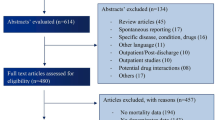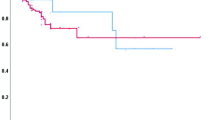Summary
Admissions during the first 6 months of 1978, 427 in all, have been reviewed in relation to their pharmacological treatment and mortality rates. They have been divided into five groups according to their diagnoses, and for mortality evaluation. Tagge's prognostic classification was applied. Length of stay, number of drugs used in each patient, and cost of pharmacological therapy, do not have a significant relation to survival.
Conclusions stress the great importance of determining uniform admission criteria to evaluate the degree of effort in money, personnel and hospital support to be spent on these kind of patients.
Similar content being viewed by others
References
Aranda JV, Cohen S, Neims AM (1976) Drug utilization in a newborn intensive care unit. J Ped 89:315
Buchanan N, Cane RD (1978) Drug utilization in a general intensive care unit. Intens Care Med 4:75
Cimetidine (Tagamet): Update on Adverse Effects (1978) The Med Letter 20:77
Civetta JM (1973) The inverse relationship between cost and survival. J Surg Res 14:441
Cullen J (1977) Results and costs of intensive care. Anesthesiology 47:203
Dixon RE (1979) Infecciones hospitalarias, un problema continuo. JANO 363:73
Gimenez Caballero ME, Garcia Romero MJ (1978) Estudio de las interacciones medicamentosas en los Servicios de Cuidados Médicos Intensivos y de Medicina Interna. Mundo Farmacéutico 4:59
Grenvik A, Babcock R, Loughead M, Powner RD, Snyder JV (1977) Different levels of therapeutic efforts in critical care. Personal report to the II World Congress on Intensive Care. Paris, 19–23 Sept. 1977, Abstract 423. Intens Care Med 3:213
Griner PF (1973) Medical intensive care in the teaching hospital: cost versus benefits. Ann Intern Med 78:581
Ibañez Juve J, Fiol Sala M, Abizanda Campos R (1977) Complicaciones cútaneas isquémicas de la dopamina. Medicina Clínca 68:190
Le Gall JR (1978) Considérations économiques et pronostiques en réanimation Revue du Practicien 28:67
Maudes Rodriguez A, Schoendorff Marin G (1978) Valoracion del enfermo crítico. Med Intensiva 2:1
Snyder J, Jatrewski M, Powner D, Grenvik A, Smith J (1977) Problems on brain death determination. Personal communication to the II World Congress on Intensive Care. Paris, 19–23 Sept. 1977. Abstract 237. Intens Care Med 3:166
Snyder JV, Porell M, Grenvik A, Stickler D, Civetta J, Augenstein J (1977) Prognosis equivalence of illness, and cost benefit in intensive care. Personal communication to the II World Congress on Intensive Care Paris, 19–23 Sept. 1977, Abstract 427. Intens Care Med 3:214
Author information
Authors and Affiliations
Rights and permissions
About this article
Cite this article
Abizanda Campos, R., Valle Herraez, F.X., Jorda Marcos, R. et al. Drug use in an intensive care unit and its relation to survival. Intensive Care Med 6, 163–168 (1980). https://doi.org/10.1007/BF01757298
Issue Date:
DOI: https://doi.org/10.1007/BF01757298




